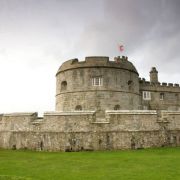
Goonhilly Satellite Earth Station is the world's largest satellite earth receiving station, located on Goonhilly Downs near Helston on the Lizard peninsula. There are over 60 communications dishes, 25 of which are in use, providing a significant proportion of the UK's satellite connectivity. The site also links into undersea cable lines.
The first communications dish was Antenna One, otherwise known as Arthur, and was built in 1962 to link with Telstar. It was the first open parabolic design and received the first live transatlantic television broadcasts from the United States. Many of the dishes are named after characters from Cornish legends. The largest dish, Merlin, has a 32 metre diameter. Other dishes are Guinevere, Tristan and Isolde.
Although the earth station is powered from the national grid, the site has large diesel generators to provide indefinite backup power in the event of a national grid outage. The satellite dishes at Goonhilly are directed at every continent, and almost all international news travels to and from Britain via the huge discs.
In the past Goonhilly handled millions of international phone calls, emails, and TV broadcasts and transmitted to every corner of the globe through space or through undersea fibre optic cables. However, satellite operations ceased at the site in 2008 and were moved to Madley Communications Centre in Herefordshire.
Up until Easter 2010 Goonhilly was a popular tourist attraction, featuring a visitor centre, tours of the dishes and "Britain's fastest cybercafé". At its peak the site attracted around 80,000 visitors a year.
Looking forward the site's future appears to be in the space industry with speculative collaborations with the European Space Agency's lunar mission and a partner in Newquay Airport's bid to become the UK's first space-port.
The downs surrounding Goonhilly formed Cornwall's first nature reserve. BT works with English Nature to preserve the natural character of the part of the countryside for which the company is responsible. There is a guided tour around the perimeter of the satellite station, taking in ancient burial mounds and a 5,000 year old standing stone. This is an Area of Outstanding Natural Beauty with some of the rarest plants in Britain, including the fragrant orchid and the hairy buttercup.





